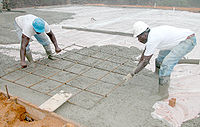
Photo from wikipedia
ABSTRACT In 1985 many mediaeval fortifications were classified as cultural heritage assets by the Spanish Historic Heritage Act, which imposed an obligation to preserve them from decay. Unfortunately, this legal… Click to show full abstract
ABSTRACT In 1985 many mediaeval fortifications were classified as cultural heritage assets by the Spanish Historic Heritage Act, which imposed an obligation to preserve them from decay. Unfortunately, this legal mandate is often difficult to fulfil in practice due to insufficient knowledge of the building materials and techniques used in these constructions, which makes it impossible to plan proper restoration work. Another problem is that these fortifications are often difficult to access, which is one of the reasons why little research has been done on them. Given that the degree of decay suffered by a building material is closely related to the environmental conditions and the natural risks to which it is exposed, as well as to the intrinsic features of the material itself, the characterization of the building materials used in rammed-earth constructions is considered a crucial aspect to implement compatible protective actions. With this in mind, we present the study of the conservation state of one of the 250 fortifications found in south-eastern Spain: the Velez castle, in the town of Mula (Murcia). The characterization of four representative samples of rammed-earth and mortars using X-ray diffraction and optical microscopy is also presented here.
Journal Title: International Journal of Architectural Heritage
Year Published: 2019
Link to full text (if available)
Share on Social Media: Sign Up to like & get
recommendations!